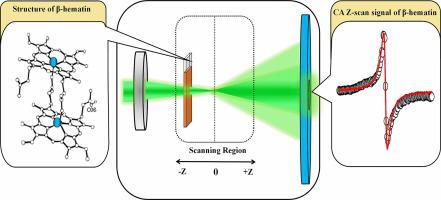Spectrochimica Acta Part A: Molecular and Biomolecular Spectroscopy ( IF 4.3 ) Pub Date : 2024-01-18 , DOI: 10.1016/j.saa.2024.123902 Priyadarshi Sahoo 1 , Nitesh Kumar Pathak 1 , D Scott Bohle 2 , Erin L Dodd 3 , Umakanta Tripathy 1

|
Hematin anhydride (β-hematin), the synthetic analogue of the malaria pigment, “hemozoin”, is a heme dimer produced by reciprocal covalent bonds among carboxylic acid groups on the protoporphyrin-IX ring and the iron atom present in the two adjacent heme molecules. Hemozoin is a disposal product formed from the digestion of hemoglobin present in the red blood cells infected with hematophagous malaria parasites. Besides, as the parasites invade red blood cells, hemozoin crystals are eventually released into the bloodstream, where they accumulate over time in tissues. Severe malaria infection leads to significant dysfunction in vital organs such as the liver, spleen, and brain in part due to the autoimmune response to the excessive accumulation of hemozoin in these tissues. Also, the amount of these crystals in the vasculature correlates with disease progression. Thus, hemozoin is a unique indicator of infection used as a malaria biomarker and hence, used as a target for the development of antimalarial drugs. Hence, exploring various properties of hemozoin is extremely useful in the direction of diagnosis and cure. The present study focuses on finding one of the unknown properties of β-hematin in physiological conditions by using the Z-scan technique, which is simple, sensitive, and economical. It is observed that hemozoin possesses one of the unique material properties, i.e., nonlinearity with a detection limit of ∼ 15 µM. The self-defocusing action causes β-hematin to exhibit negative refractive nonlinearity. The observed data is analyzed with a thermal lensing model. We strongly believe that our simple and reliable approach to probing the nonlinearity of β-hematin will provide fresh opportunities for malaria diagnostics & cure in the near future.
中文翻译:

血红素酐(β-血红素):疟疾色素疟色素的类似物,具有非线性
血红素酸酐(β-血红素)是疟疾色素“疟原虫色素”的合成类似物,是一种血红素二聚体,由原卟啉-IX 环上的羧酸基团与两个相邻血红素分子中存在的铁原子之间的相互共价键产生。 。疟原虫色素是由感染食血性疟疾寄生虫的红细胞中存在的血红蛋白消化而形成的处置产物。此外,当寄生虫侵入红细胞时,疟原虫色素晶体最终会释放到血液中,并随着时间的推移在组织中积累。严重的疟疾感染会导致肝脏、脾脏和大脑等重要器官出现严重功能障碍,部分原因是这些组织中疟原虫色素过度积累产生自身免疫反应。此外,脉管系统中这些晶体的数量与疾病进展相关。因此,疟原虫色素是一种独特的感染指标,用作疟疾生物标志物,因此可用作抗疟药物开发的靶标。因此,探索疟原虫色素的各种特性对于诊断和治疗方向非常有用。本研究的重点是通过使用简单、灵敏且经济的 Z 扫描技术来发现 β-血红素在生理条件下的未知特性之一。据观察,疟原虫色素具有一种独特的材料特性,即检测限约为 15 µM 的非线性。自散焦作用导致 β-血红素表现出负屈光非线性。使用热透镜模型分析观察到的数据。我们坚信,我们探测 β-血红素非线性的简单可靠的方法将为在不久的将来疟疾诊断和治疗提供新的机会。











































 京公网安备 11010802027423号
京公网安备 11010802027423号